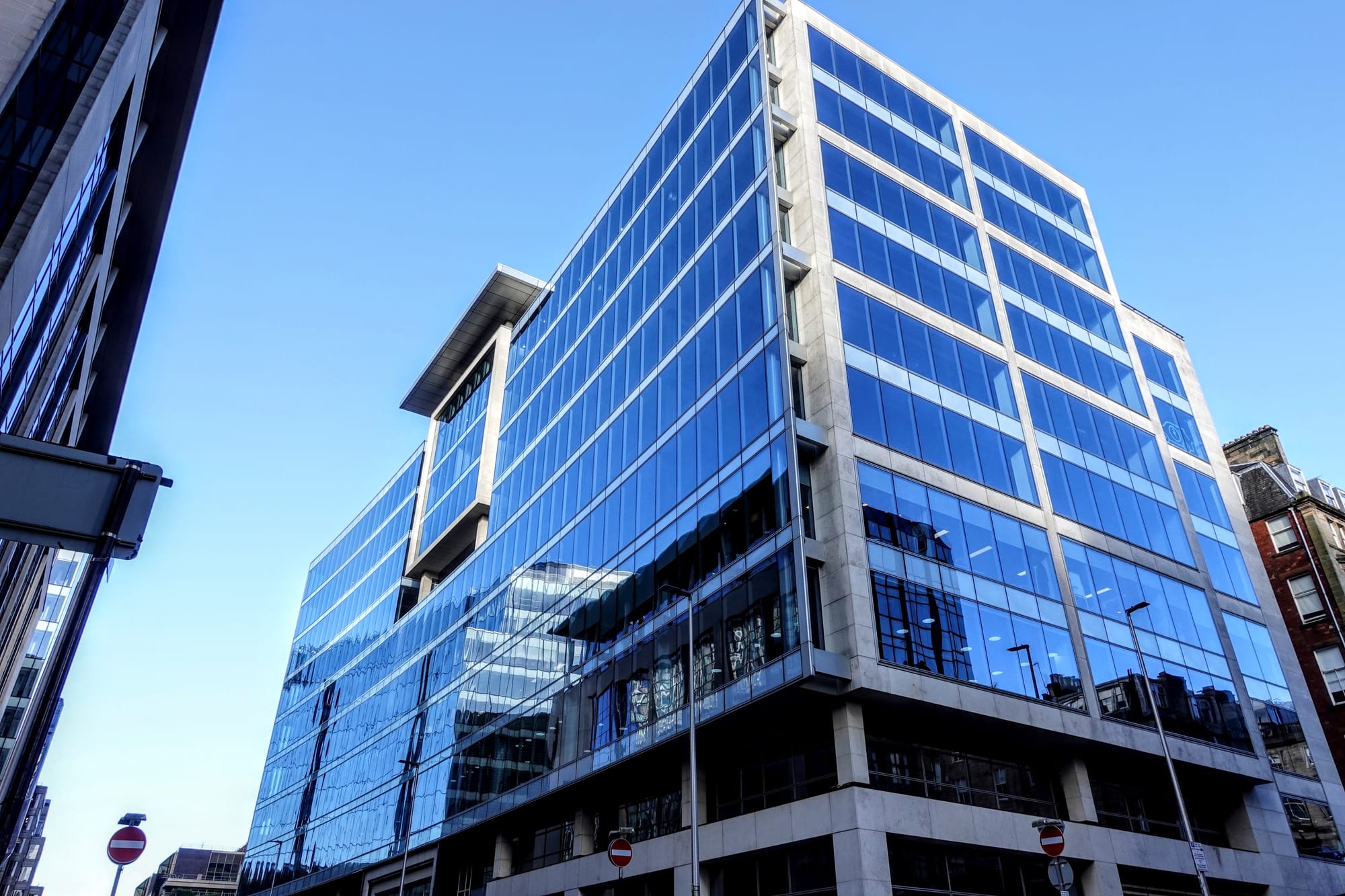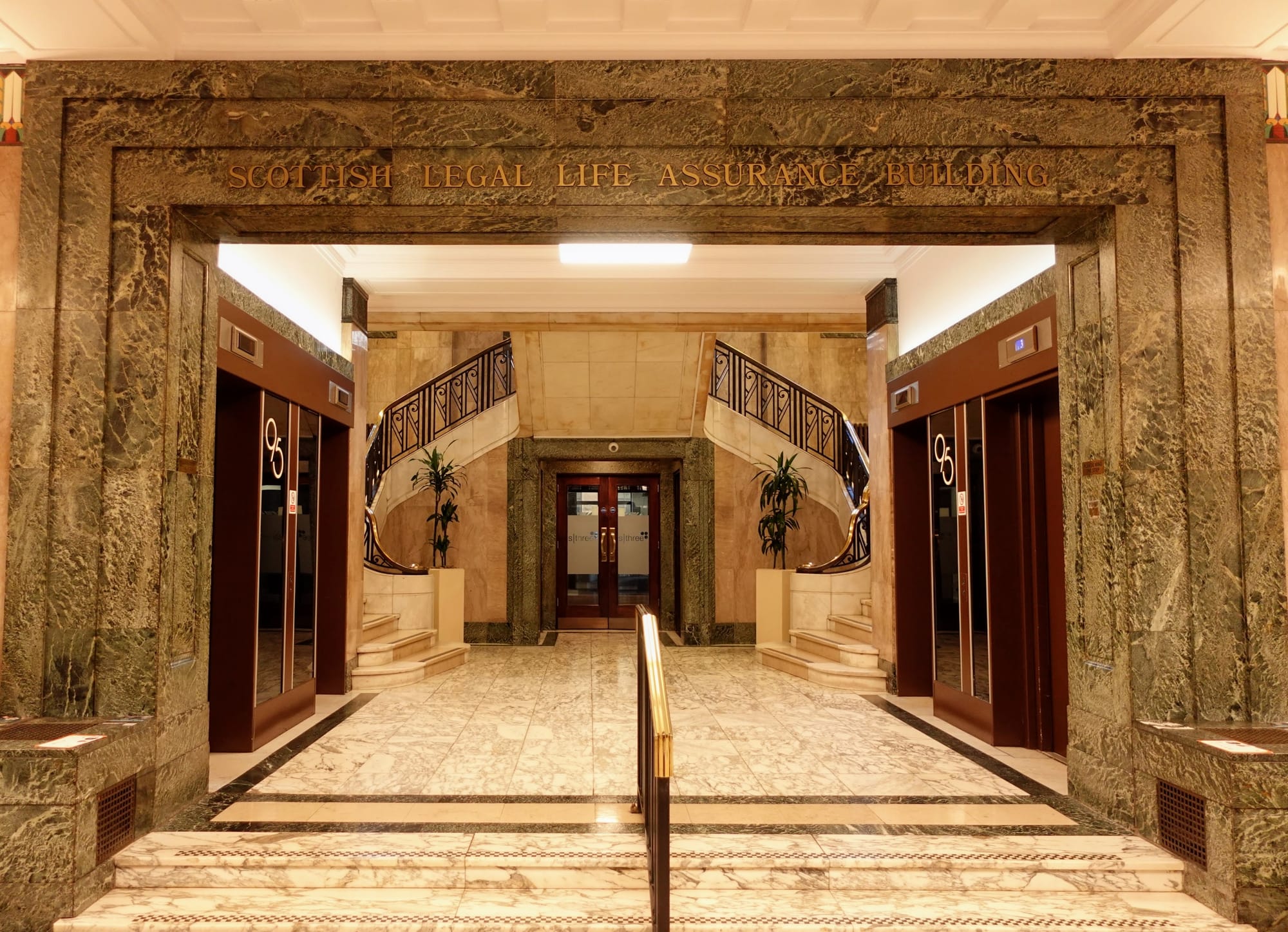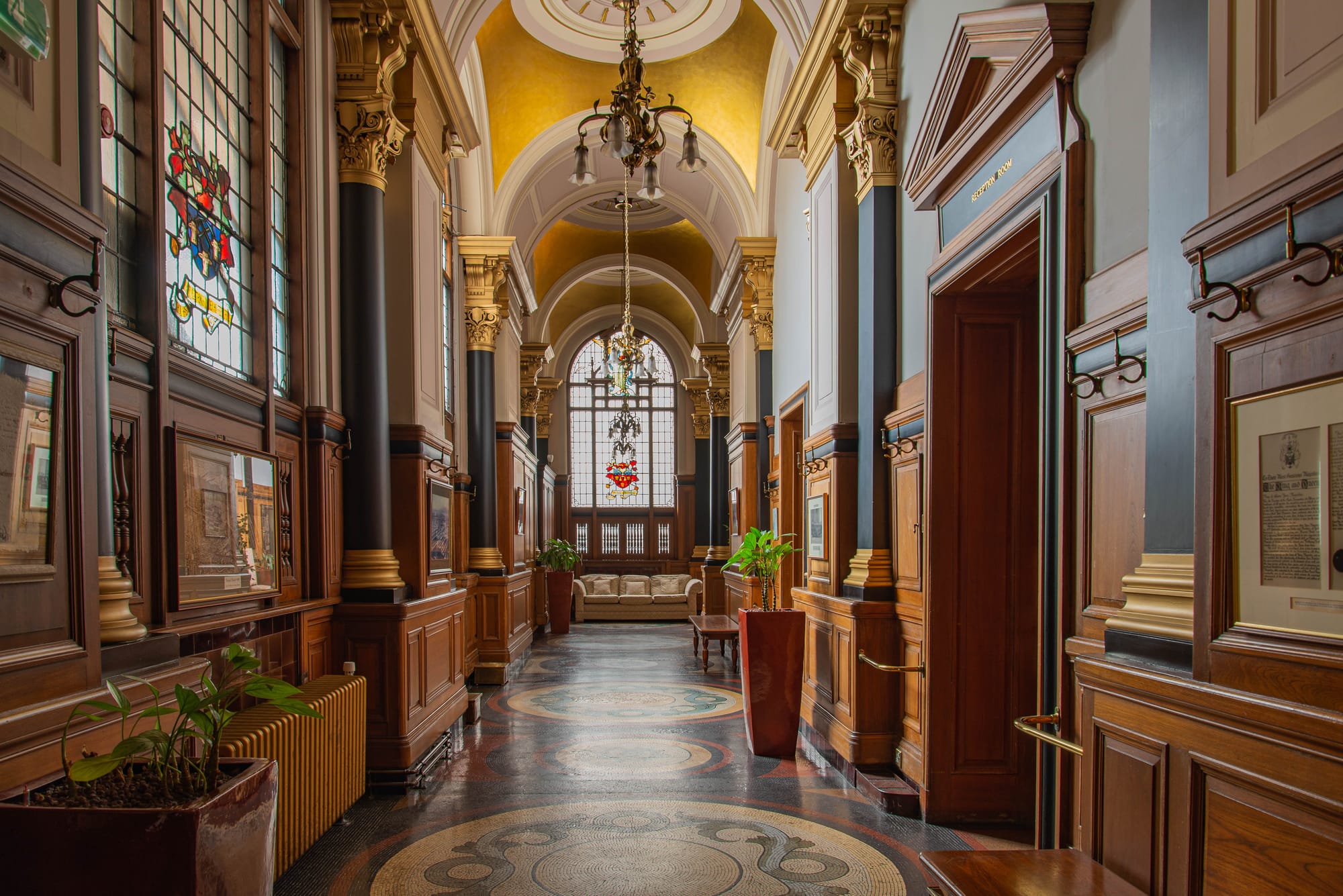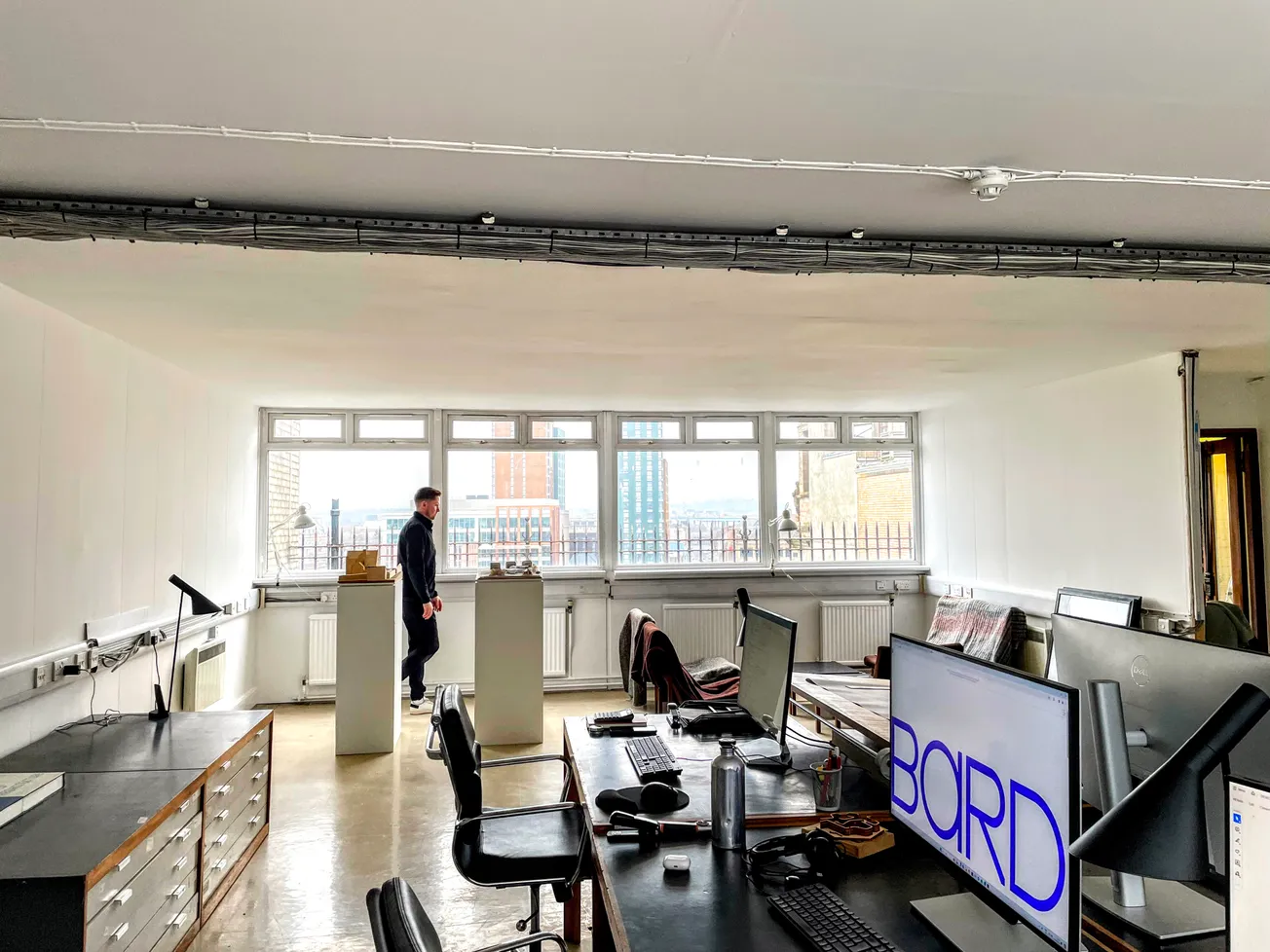The space is beautiful; a cavernous first floor, tastefully outfitted with modern furniture that complements an exposed beam ceiling. Large windows on both sides of the room allow for acres of natural light to stream in. The beneficiaries are workers dotted around six long tables, desk spaces marked by the presence of sleek leather wheely chairs. In front of a kitchen area that could double as a TikTok chef’s background, benches are set out, inviting people to mingle over meals. An imposing burgundy Chesterfield sofa and armchair sit in the opposite corner, perfect for reading breaks.
“The vibe is off,” I hiss at my colleague.
As a start-up in Glasgow, we’re on the hunt for the new Bell HQ. It turns out, we’re pretty choosy. The site we’re looking at now is perfect on paper: full of freelancers and small creative businesses, close to the city centre, with beefed up washroom facilities and event space to boot. Yet it feels wrong for us.
There are specific niggles, like the lack of private rooms to take calls in (a real drawback if you’re often chatting about sensitive information) and its proximity to the M8. But something about the general atmosphere just doesn’t gel. Perhaps it's just a bit too perfect. My colleague agrees and we quietly leave. The search continues.
It’s a small insight into a topic that potentially isn't getting enough of a spotlight in the city. There’s a lot of discussion about places to live in Glasgow; the city council announcing a housing emergency in 2023, thanks to pressures including a lack of social housing and massively increased private rents. But what about places to work?
Glasgow’s top occupation groups are traditionally office-based: administrative roles, or business and public service professionals. But their workspace needs are changing, which raises existential questions: what types of professions, or enterprises, should a city with aspirations to “increase opportunity and prosperity for all our citizens” try to make space for?
While researching this piece, everyone I talked to about offices, whether drawn from the corporate or more creative sectors, said the same thing: Glasgow has space, just not the right type.
Let's crunch the numbers. Total Glasgow office vacancy rates are some of the highest in the UK. According to commercial real estate agent, Avison Young, Glasgow has the highest availability rate for offices among the “big nine” office markets outside of London.
Part of this seems to be down to the types of workers. The concentration of public sector office jobs (like civil servants) in the city “is about 50% higher than the UK average,” says Grant Lonsdale, senior director of market analytics at CoStar. Post-pandemic, the public sector has “been slower to go back to the office,” he adds, diplomatically. There’s other reasons too: the rise of hybrid and remote workers, changing company needs and so on. But let's not start with the empties. Despite those vacancy rates, this month Savills released alarming data saying that Glasgow has “less than a year’s supply” of office space left. What gives?
Prime Time
Not all offices are created equal. The type of offices Savills – and the other market analysts I speak to – say Glasgow doesn’t have enough of are considered ‘prime’ stock, a new category that’s emerged in commercial real estate circles. Previously, offices were ranked by ‘grades’, A, B, C and so on. ‘Grade A’ offices were, unsurprisingly, considered the most desirable type; extra amenities, central location, built according to contemporary specifications in both aesthetic and infrastructure. ‘Grade A’ offices were what the big, multinational corporate employers wanted: your consultancy firms, banks and so on.
Now, however, there’s ‘prime’. David Cobban, head of Savills’ Glasgow office, says ‘prime’ refers to the buildings where landlords and developers have been able to respond to the newest post-pandemic demands from big occupiers.
These corporates aren’t impressed by decent shower facilities. Instead, Cobban tells me, they’re asking for auditoriums, podcast studios, big café spaces, breakout rooms for video calls and comfortable chairs to flop down into when the overexerted worker needs a break. Since the advent of working from home, the types of workers populating these particular glossy buildings are often used to hyper-customised environments, with more leisure time to boot. They might not live in palaces, but it’s harder to tempt people back into a corporate office if they can get all their tasks done from home and claw back precious time by cutting out the commute.
Only spaces that offer both social opportunities and mirror – or far exceed – what these corporate workers have at home will lure them back into offices and help “retain and attract the best talent,” says Cobban.
But lots of existing office space in Glasgow isn’t ‘prime’. Some are really beautiful Victorian stock. Gorgeous. Often listed as of national historic import. Others are less aesthetically pleasing post-war constructions, but still of use. Much is neglected. And not prime.
Which is how you end up with simultaneously high office vacancy rates and city market analysts saying there’s a shortage of good stock. It’s why new and renovated ‘prime’ buildings like the Aurora, on Bothwell Street, have seen such a high take up – with occupiers including PwC and flexible office operator Cubo. Reopened in August, in just two months Aurora’s owners have boasted that more than one-third of the building – Glasgow’s “most sustainable” – is already let (and yes, it’s massive and glass-fronted).

Clamour for ‘prime’ space in Glasgow is high, according to David Cobban, because of continued employment growth in professional and business services. “I’m calculating 750,000 square feet of [prime] demand out there,” he says, which includes requirements from the UK government, utility companies, banks and accountancy firms. On the other side of the ledger, he reckons there’s only 200,000 square feet of prime space currently available in Glasgow – a big imbalance. And despite there being around 400,000 square feet of Grade A office space free on the city’s market, potential occupiers are turning up their noses. They want prime.
You would expect this to create a flurry of activity to renovate lower grade offices into prime spaces. After all, many of them are empty. The city centre is littered with signs declaring vacancies. Once you start looking, a stroll through Merchant City becomes an exercise in spotting every estate agent ad affixed to grand buildings, jutting aggressively over the heads of the passing public.
On my way to scope out Aurora, I venture into another Bothwell Street building: the iconic tawny eight-story block that abuts West Campbell Street, built as the headquarters of the Scottish Legal Life Assurance Society in its heyday. Visitors step back in time; the foyer could easily be the set for any HBO drama about 1930s Wall Street stockbrokers.

Primetime maybe, but not prime. Half of the building’s floors lie empty and available for rent, I confirm via the kindly man behind the front desk, who lets me snap a few pics. When I arrive minutes later, perspiring, in Aurora’s pristine, forcefully neutral reception, the difference is not just in the decor. Photos are strictly prohibited; I’m politely told to leave my card and my request will be considered by invisible figures further up the food chain. I fear I may be waiting a while.
Prime – and publicity shy – buildings like Aurora are in short supply though. Developers are plumping instead for investing in the cheaper, more profitable student accommodation, as demonstrated by multiple projects popping up around the city, much to the chagrin of many of Glasgow’s residents. Construction costs have increased, as has the price of debt. Basically, building or refurbishing existing stock to become ‘prime’ offices currently has a lower return on investment for developers and landlords than they’d like. So they’re not doing it.
This is already having a demonstrable impact on Glasgow city centre’s population. Much has been made of the news this year that the number of people living in the maligned city centre has gone up by a third in just over ten years. But data analysis for The Bell has found that 80% of that increase has been driven by growing student numbers, with over half of city centre residents now studying full-time.
Old is gold
But the empty non-prime office space lying about is perfect for some of Glasgow’s smaller enterprises, who may have requirements beyond what a co-work can provide but not be quite ready for 20,000 square feet at Aurora. One corporate’s trash is a creative’s treasure. I get chatting to Ruairidh Moir, the energetic founder of architecture firm BARD Ailteir which, after a series of expansions, needed new premises this year.
In February, they stumbled upon a “gem” in the form of the Clydeport Building, on Robertson Street, right by Glasgow Central Station. Category A listed (by Historic Scotland, not commercial real estate agencies), with interiors that “rival the City Chambers”, there was space for BARD. Not just a bogstandard office either: the roof terrace, with views across the Clyde.
Their location has improved business, says Moir, and the quality of BARD’s work. He can’t believe there are vacancies in the building, yet it is so. “We feel really lucky for the space that we have,” he tells me, a note of marvel in his voice. “We think we have one of the coolest offices in Glasgow.”
Moir belongs to a class of office-based workers that are harder to track. Corporate office trends are monitored closely; they involve big money and so are of interest to the large players who make a living around the trade of commercial property. But there are few stats available to understand the role of the smaller fish in Glasgow’s office ecosystem: the freelancers, start-up founders and small businesses.

These people are not as easily transformed into a big flashing MONEY sign to external investors, in the way that say, Barclays Campus is. But they contribute (perhaps more so!) to a dynamic, diverse economy and working landscape. Plus, both the labour and spending of these workers tends to directly benefit the local economy rather than a multinational bank’s coffers.
One Glasgow entrepreneur shares their belief that every city neighbourhood should have smaller, collective co-work operations embedded. They want to run data on the social impact of such projects, they say, but it would set them back £20,000. “You need somebody who cares about the area to make [the idea] work”, they add. “Because it’s not a money spinner”
Glasgow needs workspaces that allow people to take risks, they say. Great ideas are born of risk; but in economically squeezed conditions, people launching a new venture need low-cost, flexible workspaces to trial endeavours that might not work out – or they may never happen at all.
Interestingly, Glasgow City Council has attempted to create government-owned flexible workspaces before. In 2016, Trongate’s imposing Tontine Building was opened by the council as a “new centre of innovation” with a £1.67m of government investment and much fanfare (and a has-to-be-seen-to-be-believed graphic design fever dream of a project trailer which contains precisely zero information about what it is promoting).
Tripping out on the Tontine Building trailer.
With a project run-time of five years, the Tontine was supposed to provide “high quality, flexible workspaces” for companies with fewer than 10 staff across tech, design, manufacturing, and creative economy sectors. Frank McAveety, then city council leader, said its opening was a “landmark” for Glasgow’s economy. “What has been created here is a business environment that will bring the type of jobs to deliver a long-term and ongoing economic boost to the Glasgow city region,” he opined. “We will see some of the brightest and most innovative young companies in Scotland based in The Tontine."
When the Tontine project concluded in July 2021, the council said the initiative had helped create 530 “full time equivalent jobs”, only six short of its initial target. But it seemed to fare less well when it came to a second pledge to support 134 businesses at the site, increasing staff numbers by “at least four per business”. Reporting on the Tontine’s outcomes, the council said it had aided “over 50 start-ups” in scaling up, highlighting several thriving tech and creative firms, although one company cited had gone into liquidation by 2023.
Glasgow is increasingly seen as fertile ground for tech start-ups in particular – so it was peculiar the council didn’t fight for funding to extend the Tontine as part of a post-pandemic economic reboot, after such a successful-seeming initial run. A private developer, who specialises in refurbishing offices, has now submitted an application to renovate the “largely vacant” Tontine.
“It was empty,” the local entrepreneur bluntly says of the Tontine’s take up, blaming mismanagement from the council attempting to run such spaces without consulting or bringing in Glaswegians with the necessary experience. “They waste the money”.
We asked the council to share occupancy rates at the conclusion of the Tontine project – and why the initiative wasn't continued – but have yet to hear back.
It’s public knowledge that the council owns at least 65 vacant properties through subsidiary company, City Property, created in 2019 in order to settle equal pay claims from thousands of former and current female employees, partly via remortgaging major buildings. But without earmarked national or regional investment forthcoming (such as the City Deal, which funded the Tontine), there isn’t the money to renovate many of these, nor the ability to subsidise new council-run workspaces.
These pressures are notable when speaking to the creative class of workers who have historically built Glasgow’s reputation as a mecca for design. In my first week settled in the city, I’m directly privy to at least three separate stories of studio heads and artists who say they’re facing eviction – some from council-owned properties. The ‘temporary’ CCA closure is yet another blow; thanks to rent subsidies from Creative Scotland, cultural tenants there were paying “buttons” for space, I’m reliably told. Ejected to face cold realities of the current workspace rental market, even for a brief time, may sound a death knell for many.
It’s difficult to know what the answer is beyond ‘more local government funding’, which is thin on the ground. Private space providers, even with the most goodwill in the world, want a profit. Some cities, like Sheffield, have had some success by creating joint ventures between the councillor and a developer. Art charity Outer Spaces is trialling one interesting model, offering temporary but totally free studio space to artists by repurposing commercial properties until they are let or sold.
Even the commercial real estate crew say creative thinking is needed. Days after our chat, David Cobban publishes a piece for Savills, warning that an “almost non-existent development pipeline” means it’s time to get innovative. Cobban suggests office-to-residential conversions as an option to help free up more housing but I note there are fewer proposals on how to produce more workspaces. “We are starting to see some action,” he writes optimistically. “More is required”. A mantra for the modern age, perhaps.
As for The Bell, we end up at Glasgow Collective, a co-working space in the East End, home to an eclectic mix of tenants. I ask about their vacancy rates: apparently, they’re currently receiving two to three enquiries a week from people looking for fixed space the organisation just doesn’t have on hand right now. Luckily, The Bell is satisfied with hot desks.
Upstairs are artist studios, provided by charity Wasps; downstairs I meet people involved in everything from social care to cake-making. Glasgow Collective is far less polished than the first workspace we viewed, with nary a Chesterfield in sight. There’s certainly not an auditorium. But within minutes of entering, we’d started making connections with our deskmates; there’s multiple private meeting rooms; plus, coffee is communal and free, not boxed off and passively aggressively labelled. It just feels right.
Do you work in one of Glasgow’s more unusual offices? What features would you need to tempt you to come in from home? Let us know in the comments below.
Comments
How to comment:
If you are already a member,
click here to sign in
and leave a comment.
If you aren't a member,
sign up here
to be able to leave a comment.
To add your photo, click here to create a profile on Gravatar.






